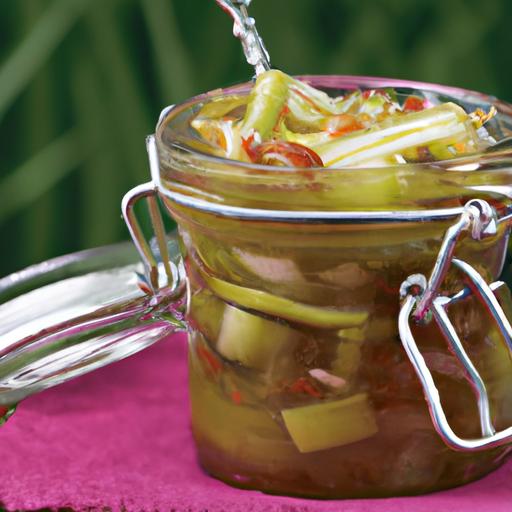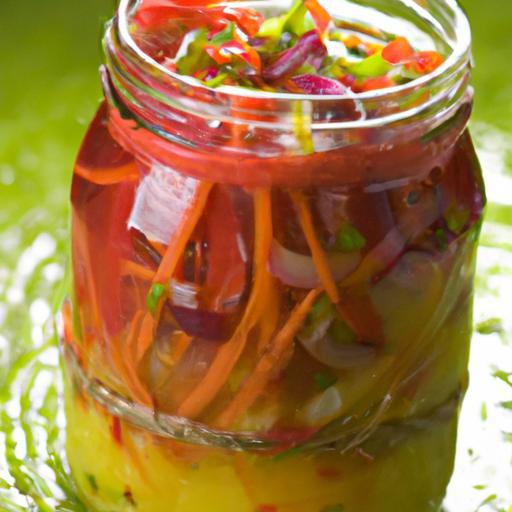In the world of homemade preserves, few joys rival the satisfaction of a perfectly crafted relish-bursting with vibrant flavors, sealed tight, and ready to brighten any meal. But before you dive into your next canning adventure, beware: even the most seasoned home cooks can stumble into common pitfalls that turn a promising batch into a kitchen conundrum. Welcome to “Relish Reboot: Avoid These Common Canning Slip-Ups,” where we’ll guide you through the essential do’s and don’ts to help your relish shine, shelf-stable and scrumptious. Whether you’re a canning novice or looking to sharpen your skills, this article is your trusted recipe for success-because the key to great relish isn’t just in the ingredients, but in mastering the craft of preservation.
Relish Reboot: Avoid These Common Canning Slip-Ups
Relish Reboot begins with mastering the foundational steps that elevate homemade preserves from just good to unforgettable. Whether you’re preserving garden-fresh cucumbers, peppers, or a medley of summer vegetables, proper techniques ensure your relish bursts with flavor, texture, and safety. Nothing beats the joy of opening a perfectly canned jar to taste a vibrant, tangy relish that dances on the palate. Let’s dive into how you can avoid common mistakes and confidently bring your canning creations to life.
Prep and Cook Time
- Preparation: 20 minutes
- Cooking: 25 minutes
- Canning and Cooling: 1 hour
- Total Time: Approximately 1 hour 45 minutes
Yield
- About 6 pint jars (16 oz each) of delectable homemade relish
Difficulty Level
- Medium – Perfect for canning enthusiasts ready to sharpen their skills
Ingredients
- 4 cups finely chopped cucumbers, peeled and seeded
- 2 cups diced green bell peppers
- 1 cup chopped onions
- 1 ½ cups white vinegar (5% acidity for safe preservation)
- 2 cups granulated sugar
- 1 tablespoon mustard seeds
- 1 tablespoon celery seeds
- 1 teaspoon ground turmeric
- 1 teaspoon salt (pickling or kosher salt preferred)
Instructions
- Sterilize your jars and lids by washing them in hot, soapy water. Rinse well, and place jars in a large pot filled with boiling water for 10 minutes. Keep hot until ready to fill.
- Prepare your relish mixture by combining cucumbers, peppers, and onions in a large bowl. Set aside.
- In a saucepan, combine vinegar, sugar, mustard seeds, celery seeds, turmeric, and salt. Bring the mixture to a boil, stirring until the sugar dissolves completely.
- Pour the hot vinegar mixture over the chopped vegetables. Stir to combine thoroughly and allow the flavors to meld for 5 minutes off the heat.
- Fill each sterilized jar with the relish, leaving a ½ inch headspace. Remove air bubbles with a non-metallic spatula by sliding it along the inside edge.
- Wipe jar rims clean with a damp cloth to ensure a perfect seal. Place lids and screw bands on firmly but not overly tight.
- Process the jars in a boiling water canner for 10 minutes (adjust time for altitude). Ensure jars are covered by at least 1 inch of water.
- Remove jars carefully and place them on a towel-lined surface. Let cool undisturbed for 12 to 24 hours. Check for proper seals – lids should not flex up or down when pressed.
- Label your jars with the date and contents, then store in a cool, dark place for at least two weeks before sampling to enhance flavor fusion.
Relish Reboot: Tips for Success
- Why sterilization matters: Proper jar sterilization isn’t just about cleanliness; it prevents contamination and extends shelf life.
- Seal with confidence: If lids pop during cooling, sterilize and reprocess or refrigerate and consume promptly.
- Texture troubleshooting: To avoid mushy preserves, use firm, fresh vegetables and cook the vinegar mixture to just boiling-overcooking can soften veggies prematurely.
- Customize your flavor: Experiment with adding finely chopped fresh dill, grated ginger, or a pinch of chili flakes for a savory kick.
- Make ahead: Relish improves with time but can be refrigerated and enjoyed within a week if unopened jars don’t seal correctly.
Serving Suggestions
Brighten sandwiches, burgers, or hot dogs with a spoonful of this vibrant relish. It pairs beautifully with grilled sausages and charcuterie boards, offering a crunchy, tangy contrast. Garnish plates with fresh parsley or a light drizzle of olive oil for an elegant touch. For an adventurous twist, use relish as a topping on creamy goat cheese crostini-simple, vibrant, and irresistibly delicious.
| Nutrient | Amount per 2 tbsp |
|---|---|
| Calories | 30 |
| Protein | 0.5g |
| Carbohydrates | 7g |
| Fat | 0g |

For in-depth safety guidelines and advanced canning tips, visit the National Center for Home Food Preservation. For more homemade relish recipes and flavor inspiration, explore our collection of savory relish creations.
Q&A
Q&A: Relish Reboot – Avoid These Common Canning Slip-Ups
Q1: What is the biggest blunder new relish canners make?
A1: The classic culprit is skimping on sterilization. Skipping this crucial step invites bacteria and mold to crash your jar party, turning your tangy treat into a petri dish faux pas.
Q2: Can I use any jar for my homemade relish?
A2: Not quite! Always opt for jars specifically designed for canning, like Mason jars. Their heat-resistant glass and airtight lids are the trusty armor your relish needs to withstand the boiling water bath’s heat and seal in freshness.
Q3: My relish tastes off after a week. What went wrong?
A3: Likely, your seal wasn’t secure. A weak seal lets in air, which not only dulls flavor but encourages spoilage. Listen for that satisfying “pop” when opening-no pop, no preserve!
Q4: How important is recipe precision in canning relish?
A4: Very! Canning isn’t a freestyle dance; it’s more like a choreographed ballet. Acidity, sugar, and salt levels keep your relish safe. Deviate too much, and you might invite harmful bacteria. Stick to trusted recipes for a winning performance.
Q5: Can I rush the cooling process after canning?
A5: Patience, please! Rapid cooling can cause jar cracks or compromised seals. Let your jars cool naturally at room temperature to keep your relish safe and sound.
Q6: What’s a common overlooked tip to prolong relish shelf life?
A6: Store your jars in a dark, cool spot. Sunlight and heat are like party crashers that spoil your jar’s vibe and accelerate spoilage. A pantry or cellar is your relish’s best retreat.
Q7: Is it okay to double the recipe in one batch?
A7: Sure, but process your jars in manageable batches. Overstuffing your canner or jars can lead to uneven heating and unsafe preserves. Each jar deserves its own spotlight and thorough boil!
Q8: My relish separated after canning-is it safe?
A8: Separation can be normal for some relishes but if the contents look cloudy, bubbly, or smell funky, it’s a red flag. When in doubt, toss it out.
Embrace these tips and dodge common pitfalls to reboot your relish game-because homemade relish should never be a gamble, but a guaranteed flavor win!
To Conclude
As you embark on your next relish-making adventure, remember that canning is as much an art as it is a science. By steering clear of these common slip-ups, you’ll elevate your preserves from mere condiments to glorious pantry treasures. A flawless relish isn’t just about flavor-it’s about safety, texture, and that satisfying pop when you open the jar. So roll up your sleeves, double-check your techniques, and relish every moment of the process. Your future self-and your taste buds-will thank you. Happy canning!


